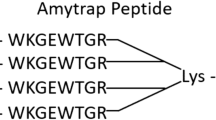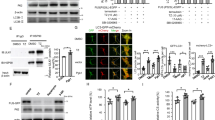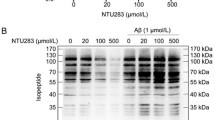Abstract
Many protein aggregation diseases (PAD) affect the nervous system. Deposits of aggregated disease-specific proteins are found within or around the neuronal cells of neurodegenerative diseases. Although the main protein component is disease-specific, oligomeric aggregates are presumed to be the key agents causing the neurotoxicity. Evidence has shown that protein aggregates cause a chronic inflammatory reaction in the brain, resulting in neurodegeneration. Therefore, strategies targeting anti-inflammation could be beneficial to the therapeutics of PAD. PHA-767491 was originally identified as an inhibitor of CDC7/CDK9 and was found to reduce TDP-43 phosphorylation and prevent neurodegeneration in TDP-43 transgenic animals. We recently identified PHA-767491 as a GSK-3β inhibitor. In this study, we established mouse hippocampal primary culture with tau-hyperphosphorylation through the activation of GSK-3β using Wortmannin and GF109203X. We found that PHA-767491 significantly improved the neurite outgrowth of hippocampal primary neurons against the neurotoxicity induced by GSK-3β. We further showed that PHA-767491 had neuroprotective ability in hippocampal primary culture under oligomeric Aβ treatment. In addition, PHA-767491 attenuated the neuroinflammation in mouse cerebellar slice culture with human TBP-109Q agitation. Further study of SCA17 transgenic mice carrying human TBP-109Q showed that PHA-767491 ameliorated the gait ataxia and the inflammatory response both centrally and peripherally. Our findings suggest that PHA-767491 has a broad spectrum of activity in the treatment of different PAD and that this activity could be based on the anti-inflammation mechanism.








Similar content being viewed by others
Abbreviations
- AD:
-
Alzheimer’s disease
- ANOVA:
-
analysis of variance
- DIV:
-
days in vitro
- DRPLA:
-
dentatorubral-pallidoluysian atrophy
- FDA:
-
Food and Drug Administration
- GFAP:
-
glial fibrillary acidic protein
- GRAS:
-
generally recognized as safe
- HD:
-
Huntington’s disease
- LSD:
-
least significant difference
- PD:
-
Parkinson’s disease
- polyQ:
-
polyglutamine
- SBMA:
-
spinal and bulbar muscular atrophy
- SCA:
-
spinocerebellar ataxias
- SCA17:
-
spinocerebellar ataxia type 17
- TBP:
-
TATA box-binding protein
- TBS:
-
tris-buffered saline
- TG:
-
transgenic
- WT:
-
wild-type
References
Aguzzi A, O'Connor T (2010) Protein aggregation diseases: pathogenicity and therapeutic perspectives. Nat Rev Drug Discov 9:237–248
Bellettato CM, Scarpa M (2018) Possible strategies to cross the blood-brain barrier. Ital J Pediatr 44:131
Bruni AC, Takahashi-Fujigasaki J, Maltecca F, Foncin JF, Servadio A, Casari G, D'Adamo P, Maletta R, Curcio SA, De Michele G, Filla A, El Hachimi KH, Duyckaerts C (2004) Behavioral disorder, dementia, ataxia, and rigidity in a large family with TATA box-binding protein mutation. Arch Neurol 61:1314–1320
Cai Z, Zhao Y, Zhao B (2012) Roles of glycogen synthase kinase 3 in Alzheimer’s disease. Curr Alzheimer Res 9:864–879
Chang YC, Lin CY, Hsu CM, Lin HC, Chen YH, Lee-Chen GJ, Su MT, Ro LS, Chen CM, Hsieh-Li HM (2011) Neuroprotective effects of granulocyte-colony stimulating factor in a novel transgenic mouse model of SCA17. J Neurochem 118:288–303
Chang YC, Lin CW, Hsu CM, Lee-Chen GJ, Su MT, Ro LS, Chen CM, Huang HJ, Hsieh-Li HM (2016) Targeting the prodromal stage of spinocerebellar ataxia type 17 mice: G-CSF in the prevention of motor deficits via upregulating chaperone and autophagy levels. Brain Res 1639:132–148
Chen ZZ, Wang CM, Lee GC, Hsu HC, Wu TL, Lin CW, Ma CK, Lee-Chen GJ, Huang HJ, Hsieh-Li HM (2015) Trehalose attenuates the gait ataxia and gliosis of spinocerebellar ataxia type 17 mice. Neurochem Res 40:800–810
Chen CM, Chen WL, Hung CT, Lin TH, Chao CY, Lin CH, Wu YR, Chang KH, Yao CF, Lee-Chen GJ, Su MT, Hsieh-Li HM (2018) The indole compound NC009-1 inhibits aggregation and promotes neurite outgrowth through enhancement of HSPB1 in SCA17 cells and ameliorates the behavioral deficits in SCA17 mice. Neurotoxicology 67:259–269
Chen CM, Chen WL, Hung CT, Lin TH, Lee MC, Chen IC, Lin CH, Chao CY, Wu YR, Chang KH, Hsieh-Li HM, Lee-Chen GJ (2019) Shaoyao Gancao Tang (SG-Tang), a formulated Chinese medicine, reduces aggregation and exerts neuroprotection in spinocerebellar ataxia type 17 (SCA17) cell and mouse models. Aging (Albany NY) 11:986–1007
Dong X (2018) Current strategies for brain drug delivery. Theranostics. 8:1481–1493
Erbayraktar Z, Alural B, Erbayraktar RS, Erkan EP (2016) Cell division cycle 7-kinase inhibitor PHA-767491 hydrochloride suppresses glioblastoma growth and invasiveness. Cancer Cell Int 16:88
Evert BO, Vogt IR, Kindermann C, Ozimek L, de Vos RA, Brunt ER, Schmitt I, Klockgether T, Wullner U (2001) Inflammatory genes are upregulated in expanded ataxin-3-expressing cell lines and spinocerebellar ataxia type 3 brains. J Neurosci 21:5389–5396
Friedman MJ, Shah AG, Fang ZH, Ward EG, Warren ST, Li S, Li XJ (2007) Polyglutamine domain modulates the TBP-TFIIB interaction: implications for its normal function and neurodegeneration. Nat Neurosci 10:1519–1528
Gostout B, Liu Q, Sommer SS (1993) “Cryptic” repeating triplets of purines and pyrimidines (cRRY(i)) are frequent and polymorphic: analysis of coding cRRY(i) in the proopiomelanocortin (POMC) and TATA-binding protein (TBP) genes. Am J Hum Genet 52:1182–1190
Han Y, Zhan Y, Hou G, Li L (2014) Cyclin-dependent kinase 9 may as a novel target in downregulating the atherosclerosis inflammation (review). Biomed Rep 2:775–779
Hsu CJ, Hsu WC, Lee DJ, Liu AL, Chang CM, Shih HJ, Huang WH, Lee-Chen GJ, Hsieh-Li HM, Lee GC, Sun YC (2017) Investigation of the bindings of a class of inhibitors with GSK3beta kinase using thermodynamic integration MD simulation and kinase assay. Chem Biol Drug Des 90:272–281
Huang HJ, Chen SL, Hsieh-Li HM (2015) Administration of NaHS attenuates footshock—induced pathologies and emotional and cognitive dysfunction in triple transgenic Alzheimer’s mice. Front Behav Neurosci 9:312
Huang C, Irwin MG, Wong GTC, Chang RCC (2018a) Evidence of the impact of systemic inflammation on neuroinflammation from a non-bacterial endotoxin animal model. J Neuroinflammation 15:147
Huang HJ, Chen SL, Chang YT, Chyuan JH, Hsieh-Li HM (2018b) Administration of Momordica charantia enhances the neuroprotection and reduces the side effects of LiCl in the treatment of Alzheimer's disease. Nutrients 10
Huang HJ, Chen SL, Huang HY, Sun YC, Lee GC, Lee-Chen GJ, Hsieh-Li HM, Su MT (2018c) Chronic low dose of AM404 ameliorates the cognitive impairment and pathological features in hyperglycemic 3xTg-AD mice. Psychopharmacology
Huang HJ, Huang HY, Hsieh-Li HM (2018d) MGCD0103, a selective histone deacetylase inhibitor, coameliorates oligomeric Abeta25-35 -induced anxiety and cognitive deficits in a mouse model. CNS Neurosci Ther
Huang HJ, Chen SL, Huang HY, Sun YC, Lee GC, Lee-Chen GJ, Hsieh-Li HM, Su MT (2019a) Chronic low dose of AM404 ameliorates the cognitive impairment and pathological features in hyperglycemic 3xTg-AD mice. Psychopharmacology 236:763–773
Huang HJ, Huang HY, Hsieh-Li HM (2019b) MGCD0103, a selective histone deacetylase inhibitor, coameliorates oligomeric Abeta25-35 -induced anxiety and cognitive deficits in a mouse model. CNS Neurosci Ther 25:175–186
Huggett MT, Tudzarova S, Proctor I, Loddo M, Keane MG, Stoeber K, Williams GH, Pereira SP (2016) Cdc7 is a potent anti-cancer target in pancreatic cancer due to abrogation of the DNA origin activation checkpoint. Oncotarget 7:18495–18507
Kamer AR (2010) Systemic inflammation and disease progression in Alzheimer disease. Neurology 74:1157 author reply 1157-8
Kazantsev A, Preisinger E, Dranovsky A, Goldgaber D, Housman D (1999) Insoluble detergent-resistant aggregates form between pathological and nonpathological lengths of polyglutamine in mammalian cells. Proc Natl Acad Sci U S A 96:11404–11409
Kiss L, Bocsik A, Walter FR, Ross J, Brown D, Mendenhall BA, Crews SR, Lowry J, Coronado V, Thompson DE, Sipos P, Szabo-Revesz P, Deli MA, Petrikovics I (2017) From the cover: in vitro and in vivo blood-brain barrier penetration studies with the novel cyanide antidote candidate dimethyl trisulfide in mice. Toxicol Sci 160:398–407
Koide R, Kobayashi S, Shimohata T, Ikeuchi T, Maruyama M, Saito M, Yamada M, Takahashi H, Tsuji S (1999) A neurological disease caused by an expanded CAG trinucleotide repeat in the TATA-binding protein gene: a new polyglutamine disease? Hum Mol Genet 8:2047–2053
Kung PJ, Tao YC, Hsu HC, Chen WL, Lin TH, Janreddy D, Yao CF, Chang KH, Lin JY, Su MT, Wu CH, Lee-Chen GJ, Hsieh-Li HM (2014) Indole and synthetic derivative activate chaperone expression to reduce polyQ aggregation in SCA17 neuronal cell and slice culture models. Drug Des Devel Ther 8:1929–1939
Lasek K, Lencer R, Gaser C, Hagenah J, Walter U, Wolters A, Kock N, Steinlechner S, Nagel M, Zuhlke C, Nitschke MF, Brockmann K, Klein C, Rolfs A, Binkofski F (2006) Morphological basis for the spectrum of clinical deficits in spinocerebellar ataxia 17 (SCA17). Brain 129:2341–2352
Li X, Lu F, Tian Q, Yang Y, Wang Q, Wang JZ (2006) Activation of glycogen synthase kinase-3 induces Alzheimer-like tau hyperphosphorylation in rat hippocampus slices in culture. J Neural Transm (Vienna) 113:93–102
Li Q, Xie W, Wang N, Li C, Wang M (2018) CDC7-dependent transcriptional regulation of RAD54L is essential for tumorigenicity and radio-resistance of glioblastoma. Transl Oncol 11:300–306
Liachko NF, McMillan PJ, Guthrie CR, Bird TD, Leverenz JB, Kraemer BC (2013) CDC7 inhibition blocks pathological TDP-43 phosphorylation and neurodegeneration. Ann Neurol 74:39–52
Liu H, Wang L, Lv M, Pei R, Li P, Pei Z, Wang Y, Su W, Xie XQ (2014) AlzPlatform: an Alzheimer’s disease domain-specific chemogenomics knowledgebase for polypharmacology and target identification research. J Chem Inf Model 54:1050–1060
Llorens-Martin M, Jurado J, Hernandez F, Avila J (2014) GSK-3beta, a pivotal kinase in Alzheimer disease. Front Mol Neurosci 7:46
McGeer PL, McGeer EG (1995) The inflammatory response system of brain: implications for therapy of Alzheimer and other neurodegenerative diseases. Brain Res Brain Res Rev 21:195–218
Mietelska-Porowska A, Wasik U, Goras M, Filipek A, Niewiadomska G (2014) Tau protein modifications and interactions: their role in function and dysfunction. Int J Mol Sci 15:4671–4713
Moller T (2010) Neuroinflammation in Huntington’s disease. J Neural Transm 117:1001–1008
Montagnoli A, Valsasina B, Croci V, Menichincheri M, Rainoldi S, Marchesi V, Tibolla M, Tenca P, Brotherton D, Albanese C, Patton V, Alzani R, Ciavolella A, Sola F, Molinari A, Volpi D, Avanzi N, Fiorentini F, Cattoni M, Healy S, Ballinari D, Pesenti E, Isacchi A, Moll J, Bensimon A, Vanotti E, Santocanale C (2008) A Cdc7 kinase inhibitor restricts initiation of DNA replication and has antitumor activity. Nat Chem Biol 4:357–365
Muhleisen H, Gehrmann J, Meyermann R (1995) Reactive microglia in Creutzfeldt-Jakob disease. Neuropathol Appl Neurobiol 21:505–517
Nakamura K, Jeong SY, Uchihara T, Anno M, Nagashima K, Nagashima T, Ikeda S, Tsuji S, Kanazawa I (2001) SCA17, a novel autosomal dominant cerebellar ataxia caused by an expanded polyglutamine in TATA-binding protein. Hum Mol Genet 10:1441–1448
Pardridge WM (2012) Drug transport across the blood-brain barrier. J Cereb Blood Flow Metab 32:1959–1972
Reichel A (2009) Addressing central nervous system (CNS) penetration in drug discovery: basics and implications of the evolving new concept. Chem Biodivers 6:2030–2049
Rubio-Perez JM, Morillas-Ruiz JM (2012) A review: inflammatory process in Alzheimer’s disease, role of cytokines. ScientificWorldJournal 2012:756357
Ryan P, Xu M, Davey AK, Danon JJ, Mellick GD, Kassiou M, Rudrawar S (2019) O-GlcNAc modification protects against protein misfolding and aggregation in neurodegenerative disease. ACS Chem Neurosci 10:2209–2221
Sapp E, Kegel KB, Aronin N, Hashikawa T, Uchiyama Y, Tohyama K, Bhide PG, Vonsattel JP, DiFiglia M (2001) Early and progressive accumulation of reactive microglia in the Huntington disease brain. J Neuropathol Exp Neurol 60:161–172
Sawaya MR, Sambashivan S, Nelson R, Ivanova MI, Sievers SA, Apostol MI, Thompson MJ, Balbirnie M, Wiltzius JJ, McFarlane HT, Madsen AO, Riekel C, Eisenberg D (2007) Atomic structures of amyloid cross-beta spines reveal varied steric zippers. Nature 447:453–457
Schmerwitz UK, Sass G, Khandoga AG, Joore J, Mayer BA, Berberich N, Totzke F, Krombach F, Tiegs G, Zahler S, Vollmar AM, Furst R (2011) Flavopiridol protects against inflammation by attenuating leukocyte-endothelial interaction via inhibition of cyclin-dependent kinase 9. Arterioscler Thromb Vasc Biol 31:280–288
Shen J, Kelleher RJ 3rd (2007) The presenilin hypothesis of Alzheimer’s disease: evidence for a loss-of-function pathogenic mechanism. Proc Natl Acad Sci U S A 104:403–409
Silva A, de Almeida AV, Macedo-Ribeiro S (2018) Polyglutamine expansion diseases: more than simple repeats. J Struct Biol 201:139–154
Stanimirovic DB, Sandhu JK, Costain WJ (2018) Emerging technologies for delivery of biotherapeutics and gene therapy across the blood-brain barrier. BioDrugs. 32:547–559
Sweeney MD, Sagare AP, Zlokovic BV (2018) Blood-brain barrier breakdown in Alzheimer disease and other neurodegenerative disorders. Nat Rev Neurol 14:133–150
Tai YF, Pavese N, Gerhard A, Tabrizi SJ, Barker RA, Brooks DJ, Piccini P (2007a) Imaging microglial activation in Huntington’s disease. Brain Res Bull 72:148–151
Tai YF, Pavese N, Gerhard A, Tabrizi SJ, Barker RA, Brooks DJ, Piccini P (2007b) Microglial activation in presymptomatic Huntington’s disease gene carriers. Brain 130:1759–1766
Takeuchi T, Nagai Y (2017) Protein misfolding and aggregation as a therapeutic target for polyglutamine diseases. Brain Sci 7
Toyoshima Y, Yamada M, Onodera O, Shimohata M, Inenaga C, Fujita N, Morita M, Tsuji S, Takahashi H (2004) SCA17 homozygote showing Huntington’s disease-like phenotype. Ann Neurol 55:281–286
van Rossum D, Hanisch UK (2004) Microglia. Metab Brain Dis 19:393–411
Wyss-Coray T, Mucke L (2002) Inflammation in neurodegenerative disease—a double-edged sword. Neuron 35:419–432
Acknowledgments
Our gratitude is extended to the Molecular Imaging Core Facility of the National Taiwan Normal University under the auspices of the Ministry of Science and Technology.
Funding
This work was supported by research grants MOST 107-2320-B-003-007, 107-2320-B-003-009, and 104-2320-B-003-009-MY3 from the Ministry of Science and Technology.
Author information
Authors and Affiliations
Corresponding authors
Ethics declarations
All of the animal experiments were conducted according to the guidelines and were approved by the Research Committee of the National Taiwan Normal University (No. 103022).
Conflict of Interest
The authors declare that they have no conflicts of interest.
Additional information
Publisher’s Note
Springer Nature remains neutral with regard to jurisdictional claims in published maps and institutional affiliations.
Electronic Supplementary Material
ESM 1
(DOCX 369 kb)
Rights and permissions
About this article
Cite this article
Chung, YH., Lin, CW., Huang, HY. et al. Targeting Inflammation, PHA-767491 Shows a Broad Spectrum in Protein Aggregation Diseases. J Mol Neurosci 70, 1140–1152 (2020). https://doi.org/10.1007/s12031-020-01521-y
Received:
Accepted:
Published:
Issue Date:
DOI: https://doi.org/10.1007/s12031-020-01521-y




